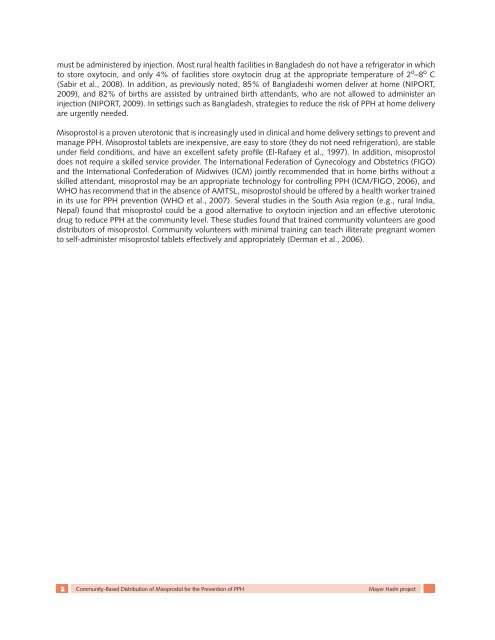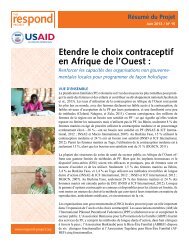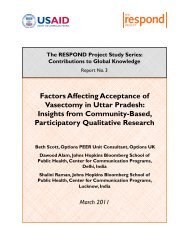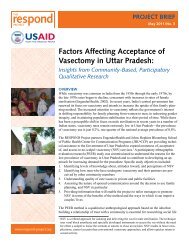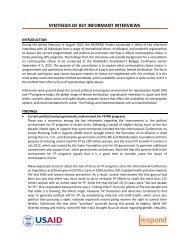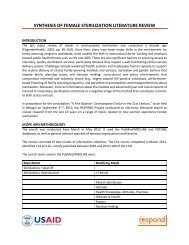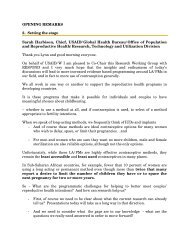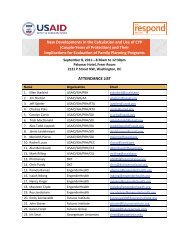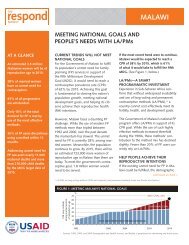Community-Based Distribution of Misoprostol for the Prevention of ...
Community-Based Distribution of Misoprostol for the Prevention of ...
Community-Based Distribution of Misoprostol for the Prevention of ...
You also want an ePaper? Increase the reach of your titles
YUMPU automatically turns print PDFs into web optimized ePapers that Google loves.
must be administered by injection. Most rural health facilities in Bangladesh do not have a refrigerator in which<br />
to store oxytocin, and only 4% <strong>of</strong> facilities store oxytocin drug at <strong>the</strong> appropriate temperature <strong>of</strong> 2 o –8 o C<br />
(Sabir et al., 2008). In addition, as previously noted, 85% <strong>of</strong> Bangladeshi women deliver at home (NIPORT,<br />
2009), and 82% <strong>of</strong> births are assisted by untrained birth attendants, who are not allowed to administer an<br />
injection (NIPORT, 2009). In settings such as Bangladesh, strategies to reduce <strong>the</strong> risk <strong>of</strong> PPH at home delivery<br />
are urgently needed.<br />
<strong>Misoprostol</strong> is a proven uterotonic that is increasingly used in clinical and home delivery settings to prevent and<br />
manage PPH. <strong>Misoprostol</strong> tablets are inexpensive, are easy to store (<strong>the</strong>y do not need refrigeration), are stable<br />
under field conditions, and have an excellent safety pr<strong>of</strong>ile (El-Rafaey et al., 1997). In addition, misoprostol<br />
does not require a skilled service provider. The International Federation <strong>of</strong> Gynecology and Obstetrics (FIGO)<br />
and <strong>the</strong> International Confederation <strong>of</strong> Midwives (ICM) jointly recommended that in home births without a<br />
skilled attendant, misoprostol may be an appropriate technology <strong>for</strong> controlling PPH (ICM/FIGO, 2006), and<br />
WHO has recommend that in <strong>the</strong> absence <strong>of</strong> AMTSL, misoprostol should be <strong>of</strong>fered by a health worker trained<br />
in its use <strong>for</strong> PPH prevention (WHO et al., 2007). Several studies in <strong>the</strong> South Asia region (e.g., rural India,<br />
Nepal) found that misoprostol could be a good alternative to oxytocin injection and an effective uterotonic<br />
drug to reduce PPH at <strong>the</strong> community level. These studies found that trained community volunteers are good<br />
distributors <strong>of</strong> misoprostol. <strong>Community</strong> volunteers with minimal training can teach illiterate pregnant women<br />
to self-administer misoprostol tablets effectively and appropriately (Derman et al., 2006).<br />
2 <strong>Community</strong>-<strong>Based</strong> <strong>Distribution</strong> <strong>of</strong> <strong>Misoprostol</strong> <strong>for</strong> <strong>the</strong> <strong>Prevention</strong> <strong>of</strong> PPH<br />
Mayer Hashi project


